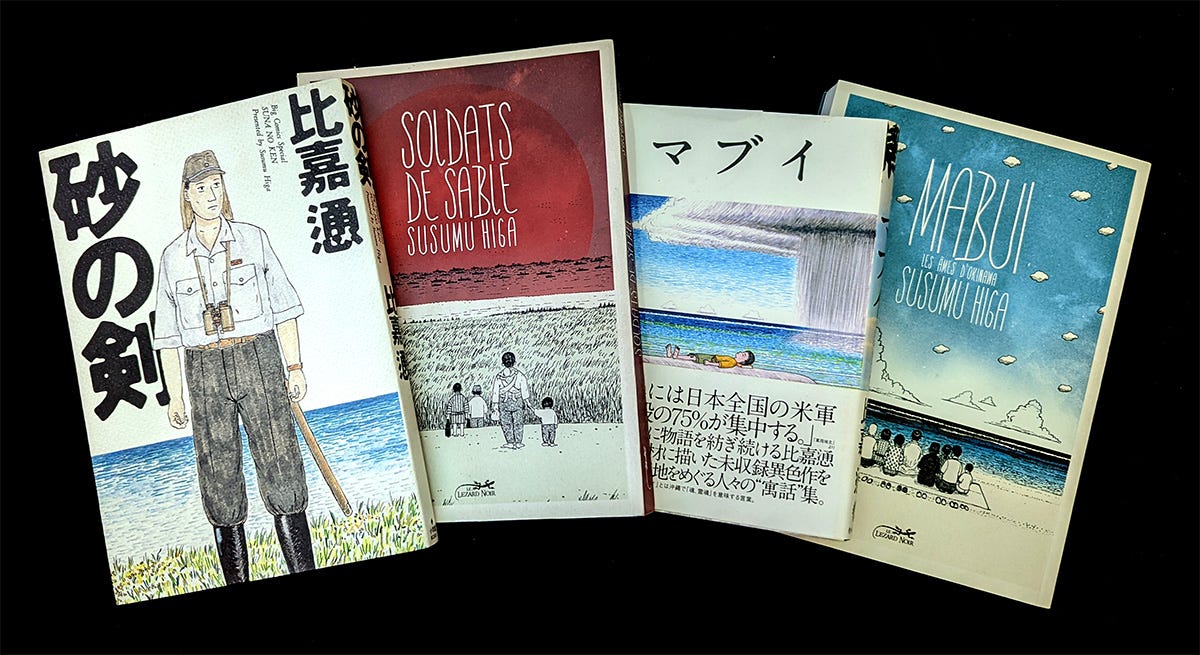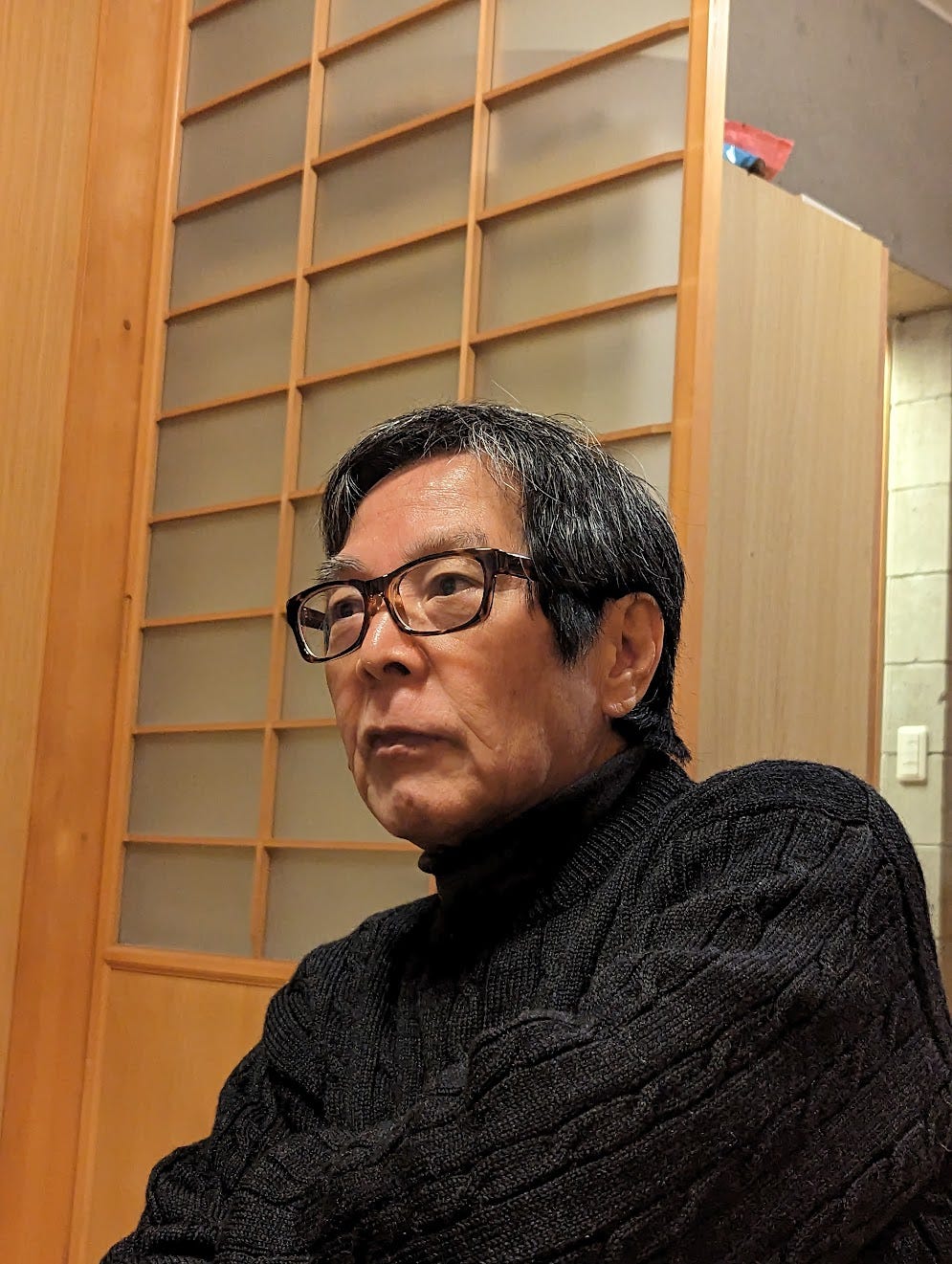INTERVIEW: Susumu Higa, on OKINAWA
A treat for paid subscribers, our interview with manga creator Susumu Higa from the print edition of Okinawa.
The following interview appears in the print edition of Okinawa, by Susumu Higa, releasing this week from Fantagraphics Publishing in finer book and comic book stores everywhere. We are reprinting it here to thank the many supporters who helped to make the serialization and publication of Okinawa on the Mangasplaining Extra Substack a success. Our sincere thank you to all of our readers, as well as to Susumu Higa for allowing us into his home, Aki Yanagi for helping to arrange this meeting, and Mitsuhiro Asakawa for setting up our early meetings with Higa-san.
SUSUMU HIGA INTERVIEW
Translated and Interpreted on site in Naha, Okinawa, by Jocelyne Allen. Conducted by Christopher Woodrow-Butcher and Andrew Woodrow-Butcher for Mangasplaining Extra (MSX).
MANGASPLAINING EXTRA (MSX): When the stories that appear in Okinawa were first published in Japanese, what was the reaction? Was there anything surprising or unexpected about the responses you received from readers?
HIGA: There was surprisingly little reaction.
MSX: [Laughs]. Did people understand the work? Especially what you were trying to say with Sword of Sand about how Okinawa had been treated by Japan and by the United States?
HIGA: I don’t know how to say this without sounding . . . I don’t mean to sound like I’m talking from up on high. But my readers are pretty high-level. I think there’s a tendency for them to be more thoughtful, more aware. I’m definitely not one of the major players; I don’t have a huge audience. In terms of manga as manga, then, I don’t get much of a reaction. But [the documentary that I worked on, Untold Stories of the Battle of Okinawa: Women and Teens on the Frontline, for NHK World], with my illustrations in it — that actually got a very good reaction from the audience. The NHK Director reached out to tell me about that and even sent me copies of the comments people made! So I really got the sense that people were watching and reacting to it. The reaction was really very positive.
But for general reader reactions, maybe it’s just because I’m not actively trying to connect with them. So with Sword of Sand and Mabui, there wasn’t any sort of tangible reaction to them.
MSX: We actually linked people to it, the documentary was available on the NHK World website for a while, so it was easy for us to tell people about it. It’s very good!
HIGA: I would’ve really liked an actual reaction to my actual manga, but . . . [laughs]. The reach of television is pretty huge.
I actually heard that [famous mangaka] George Akiyama read my stories in AX and was really moved by them. [Agent and editor Mitsuhiro] Asakawa told me that, actually.

MSX: Speaking of reaching people, I encountered Sword of Sand through the French editions from Lézard Noir and then the Japanese editions from Serinkogeisha. It always seemed like an ‘alternative’ manga to me, but I was shocked to discover that it was originally serialized in Shogakukan’s Big Comics magazine, a very mainstream seinen magazine. It really doesn’t feel like Big Comics, does it? How did it debut there?
HIGA: I wonder, myself, how I got in there! [laughs]. I wasn’t actually in the main magazine, but in the special edition, Big Comics Extra Edition, which would come out every couple of months. I did actually win the Big Comics award as well while I was there.
MSX: Oh really?
HIGA: Big Comics Extra Edition is where they can try out newcomers, or stranger work, people who only do occasional stories. My work isn’t manga-manga; it’s definitely kind of a minor world of its own. As to why they would take it up, I heard from one editor there that manga like mine, that takes up social issues and things like that, can raise up the overall quality of the magazine. To keep the quality of the magazine high, to give it more depth, they want to have stories like that in there, stories like mine.
MSX: When these books were published in 1995 and 2010, what were the differences between the reception of the books in Okinawa, as compared to in the rest of Japan?
HIGA: I’m not really interested in the reactions that way. If I started worrying about lack of reaction, there’d be no end to it. Once the French version came out, I started to get people from abroad coming all the way to Okinawa to see me. I was thinking that maybe readers in other countries have more of an awareness of the importance of these issues and are thinking more about it. Because for Okinawans, the stories I’m telling, they’re just life here. It’s just expected, obvious, natural life here. But I’m bringing different elements into the discussion of Japanese culture, and for people in other countries, that might be something new and interesting. For people here, they lived it. So I think they’re not paying too much attention to it.
MSX: How do you think U.S. readers are going to react to the work?
HIGA: Whether it’s Okinawa or the U.S., I’d hope for that element of shared humanity, of empathy for one another. Okinawa’s problems aren’t just Okinawa’s problems; they’re connected to global issues. In fact, the situation on the main islands of Japan is totally different than here in Okinawa. You can see the parallels with Ukraine and Russia right now. The situation in Ukraine isn’t just ‘someone else’s problem’ for Okinawa; it’s something we feel acutely, I think — the similarity of the situation. You can see Japan overlapped with Russia and Okinawa with Ukraine. If Okinawa went to the Japanese government and said, “we want to separate,” they wouldn’t let that happen. So there’s this tension. And I think that global connection and that tension might actually come through more for foreign readers, readers in America, more so than in Japan.
Keep reading with a 7-day free trial
Subscribe to MSX - The Mangasplaining Extra Newsletter to keep reading this post and get 7 days of free access to the full post archives.





